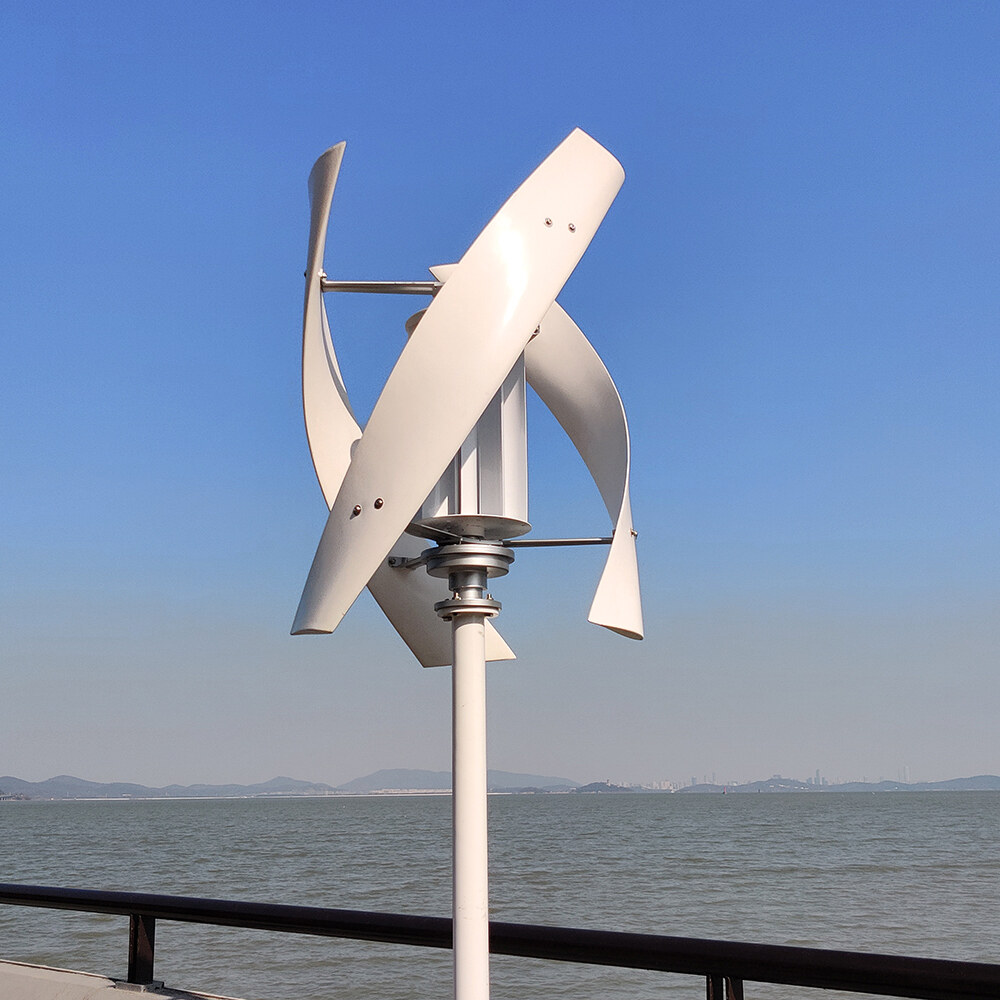Email format error
Email cannot be empty
Email already exists
6-20 characters(letters plus numbers only)
The password is inconsistent
Email format error
Email cannot be empty
Email does not exist
6-20 characters(letters plus numbers only)
The password is inconsistent


Harnessing Wind Energy: The Potential of the 2kW Vertical Axis Wind Turbine
In an era where sustainability and renewable energy are more critical than ever, the importance of wind energy cannot be overstated. Wind energy is one of the fastest-growing sources of clean energy, contributing significantly to the reduction of carbon footprints worldwide. While traditional horizontal axis wind turbines (HAWTs) have dominated the market for years, vertical axis wind turbines (VAWTs) are gaining traction, especially in residential and small-scale applications. One particular model that stands out in this category is the 2kW vertical axis wind turbine.
Understanding Vertical Axis Wind Turbines (VAWTs)
Before diving into the specifics of the 2kW vertical axis wind turbine, it’s essential to understand what sets VAWTs apart from their horizontal counterparts. Unlike HAWTs, which have blades that rotate on a horizontal axis, VAWTs have blades that rotate on a vertical axis. This unique design offers several advantages:
Wind Direction Independence: One of the most significant advantages of VAWTs is their ability to capture wind from any direction. Traditional HAWTs need to be oriented into the wind to function efficiently, which often requires complex mechanisms. VAWTs, on the other hand, do not need to change orientation, making them simpler and more robust.
Lower Starting Wind Speed: VAWTs typically start generating electricity at lower wind speeds than HAWTs. This makes them ideal for areas with inconsistent or lower wind speeds, expanding the potential for wind energy utilization in more locations.
Compact and Aesthetic Design: VAWTs are generally more compact and have a less intrusive design, which is a significant consideration for residential and urban environments. Their vertical structure also allows them to be placed closer to the ground, reducing installation costs and making maintenance easier.
Quieter Operation: Noise pollution is a common concern with large wind turbines. VAWTs, however, tend to operate more quietly, which is a crucial factor for residential installations.
The 2kW Vertical Axis Wind Turbine: A Game-Changer for Homeowners
The 2kW vertical axis wind turbine is an excellent example of how these advantages can be harnessed for practical use. Designed to be efficient, compact, and user-friendly, this turbine is ideal for homeowners looking to reduce their reliance on traditional energy sources and cut down on electricity bills.
Key Features of the 2kW Vertical Axis Wind Turbine
Optimal Power Output: With a capacity of 2kW, this turbine strikes a perfect balance between energy production and size. For an average household, it can significantly offset electricity usage, especially when combined with other renewable energy sources like solar panels. On a windy day, a 2kW vertical axis wind turbine can produce enough energy to power several home appliances, making it a valuable addition to any green energy setup.
Durability and Longevity: Built with high-quality materials, this turbine is designed to withstand harsh weather conditions. Its robust construction ensures a long operational life, with minimal maintenance required. This durability makes it a wise investment for those looking to adopt renewable energy without the hassle of frequent repairs or replacements.
Ease of Installation: One of the standout features of the 2kW vertical axis wind turbine is its ease of installation. Unlike larger turbines, which often require professional installation and significant space, this model can be installed by a handy homeowner with some basic tools. Its compact size means it can be placed in a variety of locations, from rooftops to open yards, without causing significant disruption.
Environmentally Friendly: By generating power without emitting greenhouse gases, the 2kW vertical axis wind turbine contributes to a cleaner environment. Over time, the reduction in carbon emissions from using wind energy instead of fossil fuels can be substantial, helping to combat climate change and reduce air pollution.

Real-World Applications and Benefits
The benefits of the 2kW vertical axis wind turbine extend beyond just energy savings. For those living in remote areas, this turbine can provide a reliable source of power, independent of the grid. This is particularly valuable in regions prone to power outages or where extending the grid is not economically feasible.
In urban settings, the 2kW vertical axis wind turbine can complement solar power systems, ensuring a steady supply of renewable energy even when the sun isn’t shining. This hybrid approach can maximize energy production throughout the year, making renewable energy more practical and effective.
Moreover, the compact and quiet design of this turbine makes it suitable for small communities, schools, or businesses looking to reduce their carbon footprint without compromising on aesthetics or peace and quiet.
The Role of Policy and Incentives
The widespread adoption of technologies like the 2kW vertical axis wind turbine can also be influenced by governmental policies and incentives. Many countries and regions offer subsidies, tax credits, or rebates for renewable energy systems, which can make the initial investment more affordable. These incentives are designed to encourage homeowners and businesses to adopt clean energy solutions, contributing to overall energy sustainability goals.
In addition to financial incentives, some regions have implemented renewable energy mandates or goals, which can drive the adoption of technologies like the 2kW vertical axis wind turbine. For example, local governments might set targets for renewable energy usage, encouraging residents and businesses to invest in wind turbines and other green technologies.
It’s worth exploring what incentives and support are available in your area. Many utility companies also offer net metering programs, where excess energy produced by your wind turbine can be sold back to the grid, providing an additional financial benefit and further offsetting energy costs.
Technological Advancements and Future Trends
As with many technologies, the 2kW vertical axis wind turbine is likely to evolve with advancements in technology. Future developments might include improvements in materials and engineering, which could increase efficiency, reduce costs, and enhance performance in various wind conditions.
For instance, innovations in blade design and aerodynamics could lead to more efficient energy capture and reduced noise. Advances in smart grid technology and energy storage solutions might also play a significant role, allowing for better integration of wind power with other renewable energy sources and optimizing energy usage.
Moreover, as more research is conducted and the technology becomes more widespread, economies of scale could drive down costs, making wind turbines even more accessible to a broader audience. As a result, homeowners and businesses could benefit from more affordable and efficient wind energy solutions in the future.
Community and Educational Impact
The adoption of wind turbines, including the 2kW vertical axis models, also has a positive impact on communities and education. By incorporating wind energy into local projects or schools, communities can raise awareness about renewable energy and inspire future generations to pursue careers in science, technology, engineering, and mathematics (STEM).
Educational institutions can use wind turbines as real-world examples in their curricula, providing students with hands-on experience and a deeper understanding of renewable energy technologies. This practical learning experience can foster interest in sustainability and innovation, encouraging students to think creatively about solving global energy challenges.
Additionally, community wind projects can bring people together and promote collective action towards sustainability goals. These projects often involve collaboration among residents, local governments, and businesses, creating a sense of shared purpose and responsibility.
Practical Tips for Potential Users
If you’re considering installing a 2kW vertical axis wind turbine, here are some practical tips to ensure a successful and efficient setup:
- Conduct a Wind Assessment: Before purchasing a wind turbine, assess the average wind speed and consistency in your area. This will help determine if a vertical axis wind turbine is suitable for your location.
- Check Local Regulations: Ensure you’re aware of any local zoning laws or regulations related to wind turbine installations. Some areas may have restrictions or require permits for installing wind turbines.
- Choose a Reputable Supplier: Research and select a reputable manufacturer or supplier for your wind turbine. Look for reviews, warranties, and customer support to ensure you’re getting a reliable product.
- Proper Installation: Follow the manufacturer’s guidelines for installation to ensure optimal performance. If needed, consult with professionals to assist with installation and maintenance.
- Maintenance and Monitoring: Regularly inspect and maintain your wind turbine to ensure it operates efficiently. Monitoring its performance can help identify any issues early and optimize energy production.

